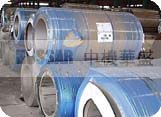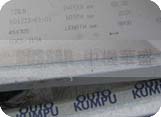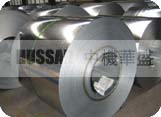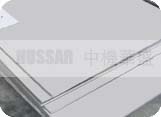| Hastelloy C-22 UNS
N06022
Hastelloy C-22, also known
as alloy C-22, is a versatile nickel alloy with enhanced resistance to pitting,
crevice corrosion and stress corrosion cracking. The high chromium content provides
good resistance to oxidizing media while the molybdenum and tungsten content give
good resistance to reducing media. This nickel steel alloy also has excellent
resistance to oxidizing aqueous media including wet chlorine and mixtures containing
nitric acid or oxidizing acids with chlorine ions. Other corrosives Hastelloy
C-22 has resistance to are oxidizing acid chlorides, wet chlorine, formic and
acetic acids, ferric and cupric chlorides, sea water, brine and many mixed or
contaminated chemical solutions, both organic and inorganic. This nickel alloy
also offers optimum resistance to environments where reducing and oxidizing conditions
are encountered in process streams. This is beneficial in multi- purpose plants
where such "upset" conditions occur frequently.
HASTELLOY C-22 alloy is a
versatile nickel-chromium- molybdenum-tungsten alloy with better overall corrosion
resistance than other Ni-Cr-Mo alloys available today, including HASTELLOY C-276
and C-4 alloys and alloy 625. C-22 alloy has outstanding resistance to pitting,
crevice corrosion, and stress corrosion cracking. It has excellent resistance
to oxidizing aqueous media including wet chlorine and mixtures containing nitric
acid or oxidizing acids with chloride ions. Also, C-22 alloy offers optimum resistance
to environments where reducing and oxidizing conditions are encountered in process
streams. Because of such versatility it can be used where "upset" conditions are
likely to occur or in multi-purpose plants.
C-22
alloy has exceptional resistance to a wide variety of chemical process environments,
including strong oxidizers such as ferric and cupric chlorides, chlorine, hot
contaminated solutions (organic and inorganic), formic and acetic acids, acetic
anhydride, and seawater and brine solutions. C-22 alloy resists the formation
of grain-boundary precipitates in the weld heat-affected zone, thus making it
suitable for most chemical process applications in the as-welded condition.
Product
Forms
C-22 alloy is available in most common product forms: plate, sheet,
strip, billet, bar, wire, covered electrodes, pipe, and tubing. Wrought
forms of this alloy are furnished in the solution heat-treated condition unless
otherwise specified. Applications
Some
of the areas of use for C-22 alloy are:
---- Acetic Acid/Acetic Anhydride
----
Acid Etching
---- Cellophane Manufacturing
---- Chlorination Systems
----
Complex Acid Mixtures
---- Electro-Galvanizing Rolls
---- Expansion Bellows
----
Flue Gas Scrubber Systems
---- Geothermal Wells
---- HF Furnace Scrubbers
----
Incineration Scrubber Systems
---- Nuclear Fuel Reprocessing
---- Pesticide
Production
---- Phosphoric Acid Production
---- Pickling Systems
----
Plate Heat Exchangers
---- Selective Leaching Systems
---- SO2 Cooling Towers
----
Sulfonation Systems
---- Tubular Heat Exchangers
---- Weld Overlay-Valves Field
Test Program
Samples of C-22 alloy are readily available for laboratory
or inplant corrosion testing. Analysis of corrosion resistance of the tested material
can also be performed and the results provided to the customer as a free technical
service. Test C-22 alloy and compare. Contact any of the convenient locations
shown on the back cover of this brochure for test coupons and information. Specifications
HASTELLOY
C-22 alloy is covered by ASME Section VIII, Division I. Plate, sheet, strip, bar,
tubing, and pipe are covered by ASME specifications SB-574, SB-575, SB-619, SB-622
and SB-626 and by ASTM specifica-tions B-574, B-575, B-619, B-622, and B-626.
DIN specification is 17744 No. 2.4602 (all forms), TUV Werkstoffblatt 479 (all
forms). NACE specification is MR-01-75. C-22 alloy falls within the range of UNS
number N06022 but has a more restricted composition for improved performance.
These improvements are of such significance that it has been widely patented throughout
the world. Material Safety Data
Sheets
For information concerning material safety data, ask for Material
Safety Data Sheets H2071 and H1072.
Nominal Chemical Composition, Weight
Percent
Ni Co Cr Mo W Fe Si Mn C V
-------------------------------------
56a 2.5** 22 13 3 3 0.08** 0.50** 0.010** 0.35**
*The undiluted deposited
chemical composition of C-22 alloy covered electrodes has 0.02% carbon and 0.2%
Si.
** Maximum a As balance
Welding
HASTELLOY® C-22® alloy is readily welded by gas tungsten arc (GTAW), gas
metal arc (GMAW), and shielded metal arc (SMAW) welding techniques. Its welding
characteristics are similar to those for HASTELLOY C-276 and C-4 alloys. Submerged
arc welding is not recommended as this process is characterized by high heat input
to the base metal and slow cooling of the weld. Base
Metal Preparation
The joint surface and adjacent area should be thoroughly
cleaned before welding. All grease, oil, crayon marks, sulfur compounds, and other
foreign matter should be removed. Filler
Metal Selections
Matching composition filler metal is recommended for
joining C-22 alloy. For gas-tungsten-arc and gas-metal-arc welding, C-22 filler
wire (ER NiCrMo-10) is recommended. For shielded metal arc welding, C-22 covered
electrodes (ENiCrMo-10; UNS W86022) are recommended. Detailed fabricating information
for C-22 alloy is available in the booklet, Fabrication of HASTELLOY® Corrosion-
Resistant Alloys (H-2010) and C-22® Alloy Welding Information (H-2066).
This
nickel alloy resists the formation of grain-boundary precipitates in the weld
heat-affected zone, thus making it suitable for most chemical process applications
in the as-welded condition. Alloy
C-22 should not be used in service temperatures above 1250F due to the formation
of detrimental phases which form above this temperature. Although
ductile enough to be formed by cold working, intermediate annealing may be necessary
due to work hardening. Forging should be performed between 1750-2050F followed
by rapid cooling. Annealing can be performed at a temperature range between 2020-2150F
followed by a rapid quench. Cooling at an accelerated rate avoids the formation
of detrimental phases which form between 1400-1800F. Welding can be done by gas
tungsten-arc, gas metal-arc and shielded metal-arc processes.
|










